Hollises of McClain County Oklahoma

The surname Hollis originated in Nottinghamshire England and comes from Anglo-Saxon
etymologically, for the holly tree. It was probably adopted as a placename by a family
who lived near a particular outcropping. Use of the name might also have had a religious
basis, where not only was holly adopted as a Christian symbol, it had a positive meaning
going back to Celtic druids. Hollis is distinct from the surnames Holly, Holley, and
Hollin. I don't know how many different clans adopted the name, but the Y-DNA of ours
comes from a stunningly unexpected origin. I will get to that when the documentary trail
ends.
Taylor Albert Hollis 1890-1972
In the first phase of this story, we'll begin with individual men in the line, going
backward from my great-grandfather, for all of them that I know the names of. The second
phase will cover what can be determined from the surname and where it departed for America,
and the Y-DNA which tells a tale that goes all the way back, not just through written
history, but to the very beginnings of humanity. The final phase will cover the rest of
the family tree of Eli Hollis, my great-great-grandfather, through all of his great-great
grandparents. Keep in mind that most of them lived their lives before the Revolution, and
information for the most part becomes sketchy. I've had to rely on DNA to even identify
our relation to many of them.
My great-grandfather Taylor brought our Hollis line to Oklahoma in 1910. They lived in
Wayne, in the area that had been part of the Oklahoma Land Rush. Taylor was born in
Alabama and his father had moved the family to Titus County Texas in the 1890s. Taylor
learned of the first Land Rush when he was nine years old, and I guess it planted a seed
of interest in Oklahoma for him. One interesting thing I know about Taylor was he
registered to fight in both World Wars, the second at the age of 52. Taylor was born
1890 in Anderson, Lauderdale County Alabama near Muscle Shoals. Taylor's father was Eli
Hollis, who was born 1849 in Campbell County Georgia near Atlanta. Atlanta was founded
in 1836 after a rail station was established there, and it became the rail hub of the
south. It was the strategic importance of the supply lines that drew Union attention to
Atlanta in the Civil War. Eli was 13 when the War started and 16 when it ended. I've
seen a claim that he was taken prisoner on an island near Mobile during the War. I
suppose that Campbell wasn't directly put to the torch like Atlanta, but in the early
1870s multiple generations of our Hollises pulled out stakes and moved to Randolph County
Alabama. Eli's father Elias was born in 1801, so he was 61 when the War began. Elias
died probably not very long after the family arrived in Alabama.

Taylor Albert Hollis
The Genealogical Mystery of Elias Hollis
When I began building my first family tree on Ancestry.com, I trusted everything it told
me. One of the curiosities was Elias Hollis, who evidently took his mother's maiden name
instead of his father's surname. The parents returned for Elias were Charles Johnston
and Leander Hollis. I don't remember there being any other suggestion. I wondered then
why Elias so identified with his mother's family and not his father's. I actually told
my grandmother that she was a Johnston and not a Hollis. I'm not sure if she ever took
that seriously. She didn't seem to care. Unfortunately I didn't figure out that it was
flat out wrong until after she passed.
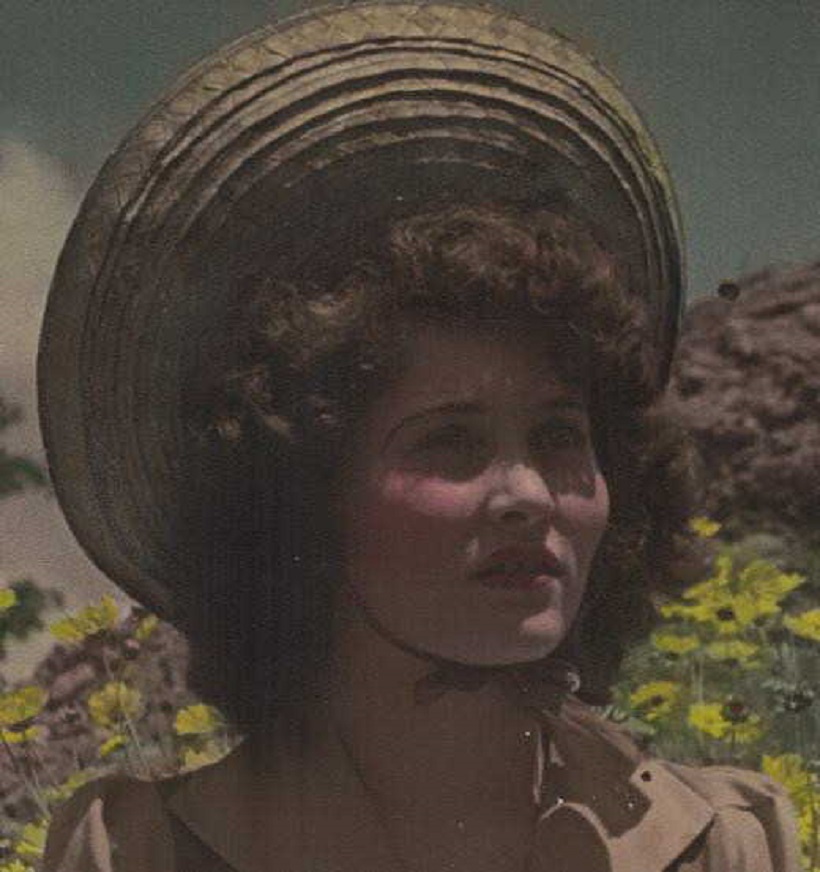
Evelyn Fairy Hollis
When I built that first tree, I was very keen to see where all my family lines led to. I
filled it out as deep and wide as I could. It became clear very soon that when multiple
options were returned for potential parents at each generation, picking the closest one
to a consensus amongst other Ancestry.com members was no way at all to guarantee
accuracy. And the deeper you go in time, the more uncertainty is encountered, and there
are lots of trees out there with bizarre situations. There are many children born before
their parents were adults, even before they were born themselves, and lots of times after
they were dead. Some lines even loop back on themselves.
It was an entertaining exercise, finding that I descend from Shakespearean Scottish Kings,
Old King Cole, famous Scandinavians like Ragnar Lodbrok. It gets silly. Some people are
evidently determined to have all their family lines converge in the Holy Land two thousand
years ago. The Netherlands Genealogical Database has Norse Gods as real people,
ultimately with Odin born in Afghanistan. But I did really want to know who I descend
from, as deep in time as possible. So, as I got more serious about getting to the truth,
I made a new tree where I vetted all info the best I knew how, indicating ancestors I
considered proven, and why I did. I still tried to push it as far in the past as I could,
and I developed a notation system for confidence at each generation and tracked when it
reached a point where there was no sense looking farther back.
One of the discoveries I made in that work was Elias Hollis's parentage. The key to
figuring it out was first making a serious attempt to identify Hollises who could've been
his father. I analyzed censuses and identified the Hollises of Fairfield South Carolina
who seemed to follow the same path as Elias. That led me to Moses Hollis who wed Rosannah
Hagan. Rosannah's will listed her inheritors. In the list was a Leander Johnston.
So, that was interesting. Elias's mother had been named Leander Hollis by other
ancestry.com members. There's a website that has an analysis of the will, and points out
that women at that time were represented in legal documents by their husbands. But the
creator of the site still thought Leander Johnston was the married name of Leander Hollis.
That led someone once upon a time to identify Charles Johnston as her husband.
But Leander is actually a man's name. Leander Johnston was the husband of a daughter of
Rosannah who wasn't named in the will at all. Whoever it was that believed one of Moses's
sons was Elias's father was correct. But they got confused and ended up choosing one of
his daughters. The answer to the mystery was Elias's mother wasn't Leander Hollis and his
father definitely was not a Johnston. There never was a Leander Hollis. Leander Johnston
was Elias's uncle.
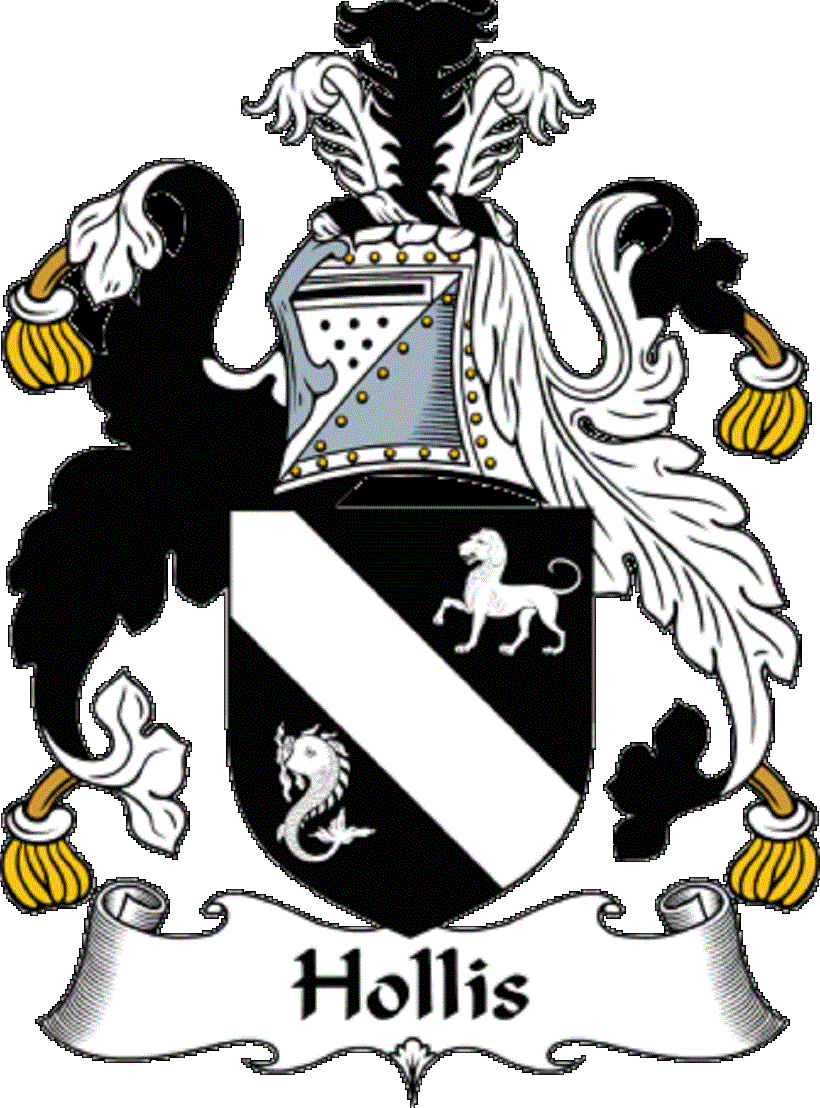
I'll get to evidence for Moses as Elias's grandfather, but for now let's return to our
line's path. Elias was born in Fairfield South Carolina. Our Hollises there were
slaveholders. Moses owned four slaves in 1790. But Elias never had slaves. That was left
behind when he moved west into Georgia. Elias was 14 when the War of 1812 ended. So, the
Creek War was done with when our Hollises moved to the Atlanta area. Moses had several
sons, all named in Rosannah's will. By analyzing census records, I was able to narrow
down to Moses Jr as the most likely father of Elias. Moses Jr also had a son Moses, so
I'll refer to the two in my line as Moses I and Moses II, with Moses III having been
Elias's brother. Though I haven't found direct documentary proof, ThruLines trace our
Hollis line through both Moseses and earlier generations. Moses II was born in 1758.
I've found three example cousins who descend from Moses II by independent paths through his
sons Berryman and Elijah and his uncle James. I've found three example cousins who descend
from Moses I by independent paths including via his daughter Jemima. Two more connections
are made to Moses I's brothers and sisters, so Moses I was an ancestor. Also note that
Moses II's sister Susannah was Elias Hollis's maternal grandmother, so we actually have two
Hollis lines.
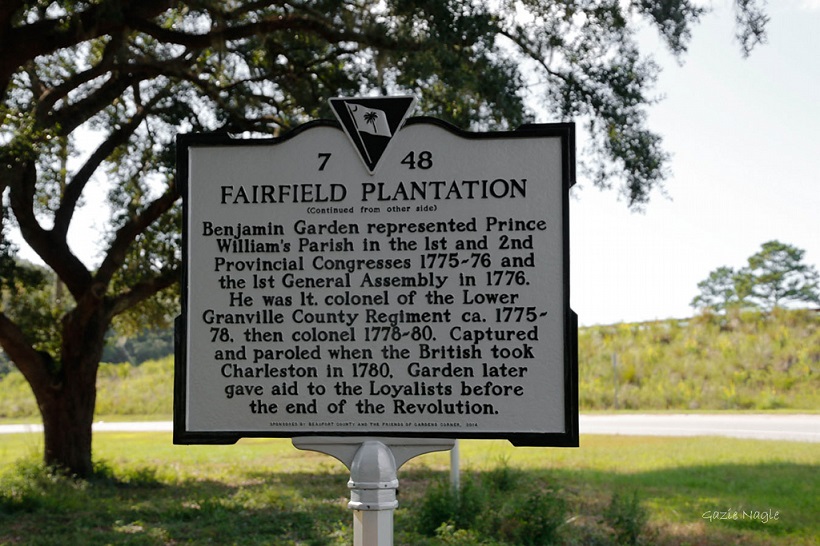
Moses II died in Fairfield in 1815. Moses I came to Fairfield in the 1780s, being
enumerated in the 1780 census in the Camden district of South Carolina. Fairfield was
formed out of Camden in 1795. Moses I had raised his own family in Fairfax County Virginia,
so Moses II was born there. A very interesting thing to consider is that Moses I was born
1728 in Fairfax. Mount Vernon is in Fairfax. George Washington was born in 1732. Moses I
Hollis and George Washington weren't peers, as Washington was wealthier by far than any
ancestor of mine at that time. But they were of similar age and lived in the same county.
Our Moses I was out of Fairfax by the Revolution, and he fought in the Fairfield patriot
militia, though he turned 48 in 1776. A John Hollis fought at King's Mountain.
Didn't Expect THAT!
A John Hollis who died 1768 in Fairfax County Virginia has been suspected by others,
before I researched Hollises myself, of having been Moses I's father. And ThruLines backs
it up. I've found two cousins who connect independently to John's daughter Isabella and
son James. Many researchers believe that John's father was Benjamin from
Surrey England, but the birth years have Benjamin becoming a father at 14 years old.
ThruLines actually suggests that Benjamin was John's brother and John Sr was the father.
I'll get to evidence of why our line came to America earlier than this John. There was a
long line of Johns, actually.
But before we delve further into how our Hollises got to Virginia, it's time to introduce
Y-DNA to the picture. Normally Y-DNA is deep-past information and has no impact on our
time in America. But our Hollis line is a special case. Male descendants have tested as
haplogroup E-M2. Below is a map of the distribution of E-M2 today.
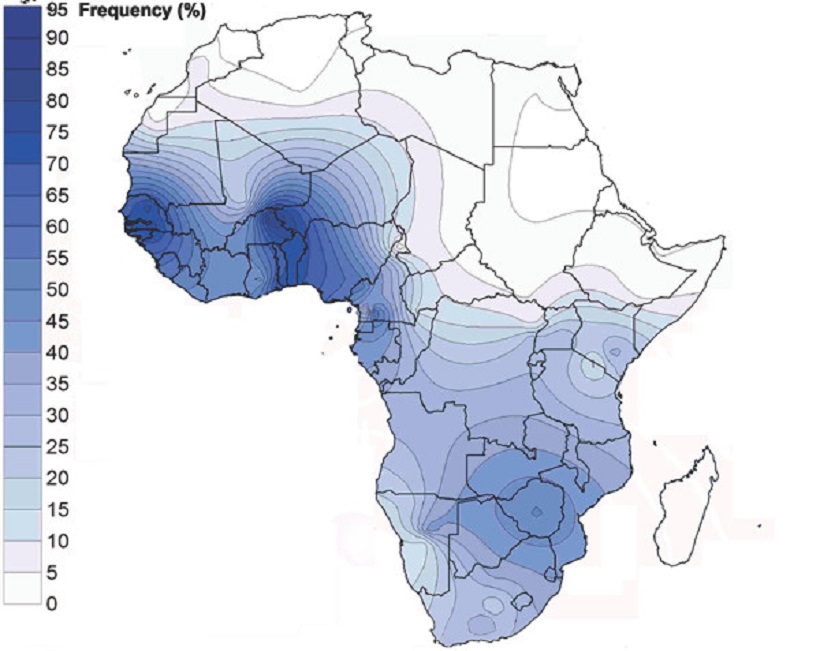
Y-DNA haplogroup E-M2 distribution
As I said, Hollis is an English surname. Y-DNA supports the theory that all humans came
originally from Africa. But E-M2 essentially never left Africa! How in the world could
our Hollises (who look Scandinavian if anything) come from a haplogroup that doesn't
register in any significant amount outside Africa? E-M2 originated in sub-Saharan
Africa, and tended to spread farther south if anything.
The first thing I noticed when researching Hollis Y-DNA is I couldn't find a FamilyTree
project for it. It turns out that Hollises actually show up in the Goins DNA Project.
Then I found a website by a guy of last name Goyen (an alternate form of Goins) who is
haplogroup E-M2 and has puzzled over how both Goins and Hollis descend directly from
sub-Saharan Africa. He knew that the Hollises of Fairfax Virginia and Fairfield South
Carolina were neighbors with the Goinses in both places. So, he deduced that both
couldn't have independently gotten such a left-field common ancestor. He concluded there
had to be an adoption or non-paternal event where the Hollis we all descend from was
actually the son of a Goins who was African. Then a contributor to his blog said the
answer was a John Gowen who came to Virginia in the 1630s from Angola was the source of
E-M2 in both lines.
At first blush I found the idea unlikely, that any Hollis or Goins could've been
categorized as white (and they are in the census) after just a few generations of
descent from an Angolan. And then I found clear proof that this theory is wrong.
I don't know much about John Gowen of Angola, but I'm certain I don't descend from him.
The Goins FamilyTree project actually has dozens of different-surnamed people in the
southern United States who are E-M2. We have other lines in our own family tree that
have it. I expect the majority have always been "white". They couldn't all have come
from John Gowen anyway, or mass adoptions and NPEs of other African Americans.
The answer is that even though our Hollis Y-DNA doesn't make sense as coming from England,
I believe the common ancestors of all these E-M2s were around 2000 years ago and they were
indeed English (and maybe some were Scottish). I'll let you wonder about that for a while
before I explain after we've explored how our Hollises came to America.
The Hol-ly Hallowes
So, I believe that our John Hollis of Fairfax Virginia was the son of a long line of
English Hollises. But they lived too long ago for ThruLines to help to prove their identities, and neither does
documentary evidence. It's not critical to know exactly where in England they came from
(the name originated in Nottinghamshire but has spread all over the country),
but there was an interesting Hollis of Northumberland County Virginia who I believe was
our ancestor. His name was John and his last name was recorded as Hallowes. He was on
a voyage of the Ark and the Dove in 1635, and he went to the newly-founded colony of
Maryland. John Hallowes came to Maryland four decades before Patrick McAtee. John was a
Protestant and Patrick a Catholic. But they didn't directly cross paths. See the
painting below of what the scene at St Mary's might've been like in 1635.
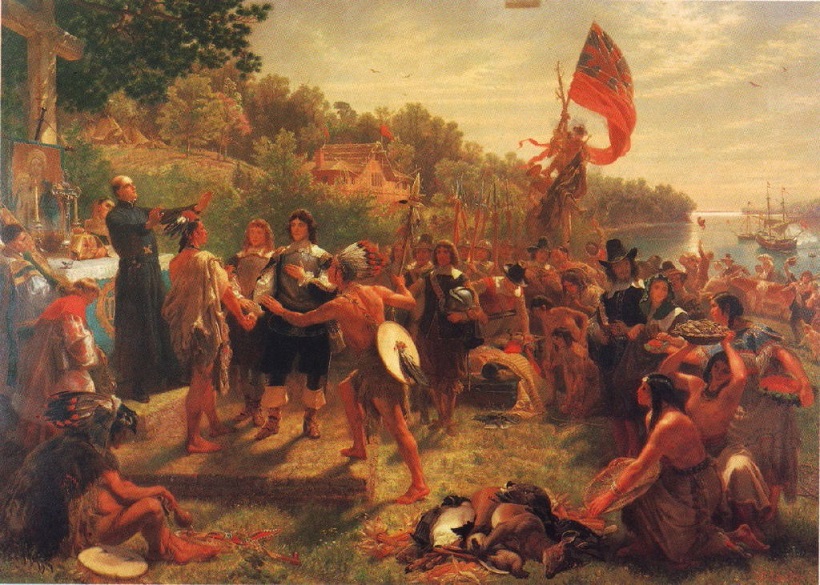
St Mary's City Maryland, 1860 interpretation of 1634 event
John Hallowes served an indenturement to Thomas Cornwallis until 1639. St Mary's City
was almost purely Catholic to my understanding, so it may be that Protestants like John
were separated from them. I know that John was at St Mary's or very close to it, because
there's a Hollis lake very near by. I'm certain it's no coincidence, because this John
Hallowes named several geographic features after himself, which I'll get to. And though
his name was spelled Hallowes in documents, he was John Hollis. Spelling wasn't very
consistent in the the 17th century, to say the least, and Hallowes is quite a creative
way for someone to have spelled Hollis. Anyway, John seems to have defended the Calverts
at this time. There had to be genial relations in order to have gone to St Mary's in the
first place. The Calverts who ran Maryland were known for religious tolerance. After
1639 John became active in trade, particularly with Native tribes of the area, and he
acquired property nearby. He was quite obviously an industrious man.
Sadly, at least from my perspective, general conflict between Anglicans and Catholics
spread to the colonies during the English Civil War, and John Hallowes joined Ingle's
Rebellion in 1645. The Calverts were then deposed from power in an attempt to make
Maryland a Protestant colony. But the Calverts regained control (at least for a few more
decades and through Patrick's time at St Mary's). In 1647 John Hallowes was asked to
declare fealty to Lord Baltimore, but he refused and relocated to the other side of the
Potomac in Virginia.
A point of interest in the English Civil War was a Denzil Holles who was one of five men
whose attempted unconstitutional arrest by King Charles I in 1642 sparked the War. I
don't know how John Hallowes related to him, but Hollis is known to have come from
Derbyshire and Nottinghamshire and Denzil Holles and his ancestors were from that region.
Ingle's Rebellion was triggered by Virginians who'd settled on islands that were claimed
by Maryland, so it's quite evident that John Hallowes was sympathetic to them. By the
time John died in 1657, he was called Major John Hallowes and was one of the richest men
in the Northern Neck of Virginia. He was only 45 years old and had many enemies, so I
wonder if he died of some waterway-related incident. He built a fortified house in
Nomini Bay that was excavated in modern times and turned up all kinds of artifacts. See
the next two images, a map of John's properties on the Potomac (note Hollis's Cliffs),
and a schematic of his compound in
Nomini Bay.
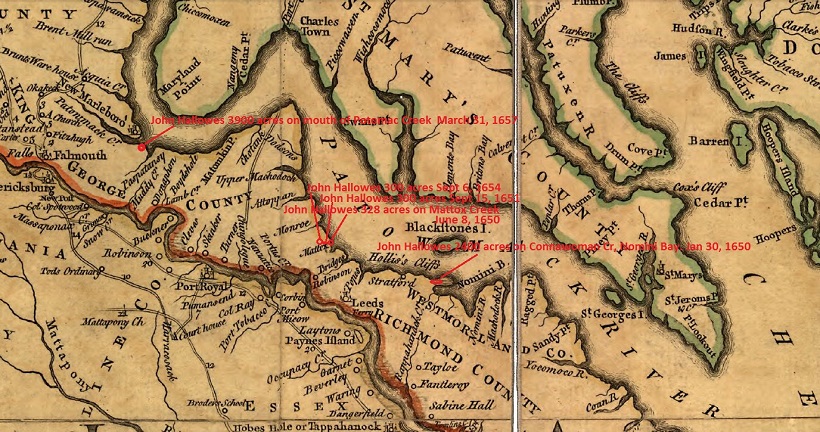
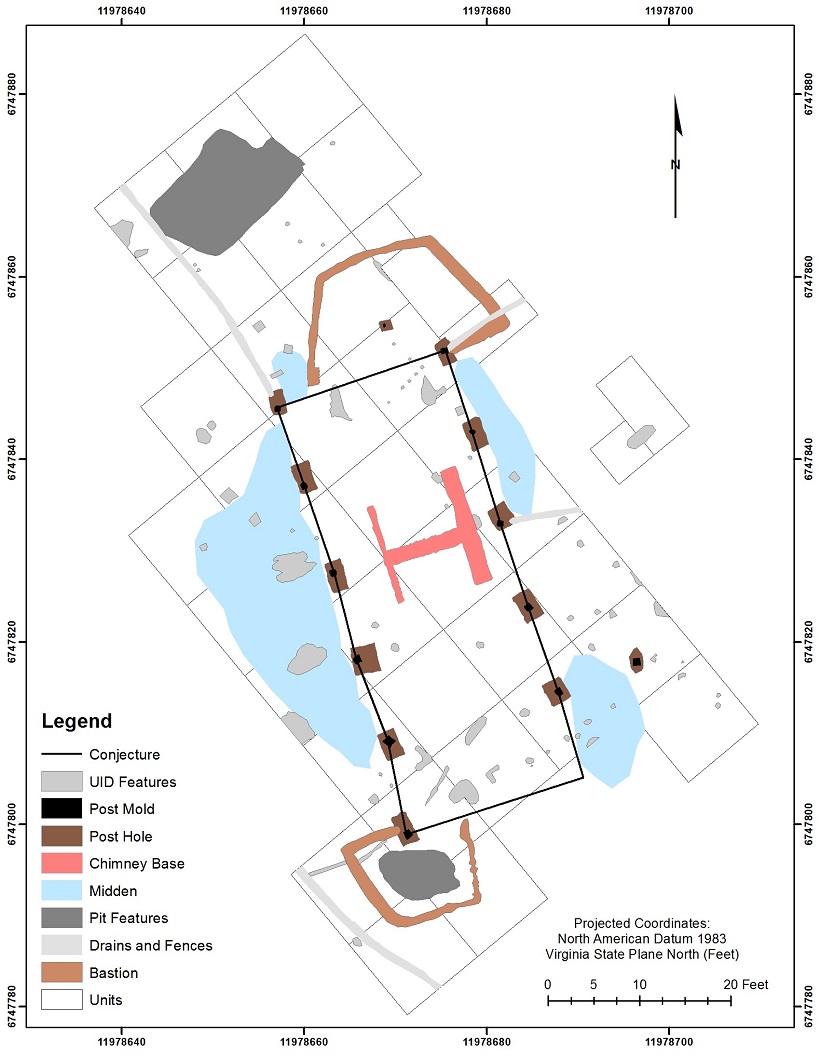
I don't know of any clear documentary connection from John Hollis of Fairfax to John
Hallowes of Nomini Bay. But one notable indication is Gowens were neighbors of Hallowes
at Nomini, and it seems quite evident these are the same two familes that would
move together to Fairfax. I'm confident that we descend from John Hallowes. The site
of the Hallowes property was Currioman Bay at the juncture of Nomini Bay and the
Potomac River. It was abandoned by 1681. When Moses I departed Virginia, it began a
trek for our line through South Carolina (3 decades), Georgia (6 decades), Alabama (2
decades), Texas (1 decade), and Oklahoma (6 decades). Our Hollises had been in Virginia
for upwards of 14 decades. Major John was born north of Manchester England, which
happens to be about the midpoint between Nottinghamshire and Carlisle, and the latter
will come into play in our Hollis story presently.
Carpet Makers?
Before I explain how I believe our Hollis line originated in Africa, as is dictated by
Y-DNA, the history of which goes back in time two thousand years, let's consider other
possibilities. I'm very confident that John Hallowes brought the line to America in
1635. The one obvious place to look for African ancestry among English people is the
slave trade, as the Goyen man guessed as I explained before. There were African
slaves in England at the same time the practice ramped up in the colonies. Now, it
seems plainly evident to me that John Hallowes was a white man. I've already addressed
that the Hollises in the 18th century were all categorized as white. Refer back to the
photo of my great-grandfather Hollis. I don't know when the first African slave was
taken to England, but I'm absolutely positive that it wasn't early enough for one of
them to have been freed and then mixed into the English population to produce a white
Englishman John Hallowes, who was born about the time that Jamestown was founded. The
only other connection that I'm aware of between England and Africa was the Corsairs who
came from the north and west African coast and actually took slaves from Britain.
I seriously doubt that one of them managed to settle down in England. I don't expect
that his kind was welcome.
But it turns out that the actual source of the Hollis line came from the same part of
Africa: the Barbary Coast, but much much earlier, long before it acquired that name.
The fact is that Britain was a melting pot of different cultures long before America
was. Every population on earth is a combination of different elements, but Britain is
much more diverse (and has been for a very long time) than you might realize. I've
pointed out that my four great-grandfather paternal lines come from the four basic
parts of Britain: Irish, Welsh, Scottish, and English. The Irish came from the
standard R-M269 Celts. The Welsh actually originated from Vikings. Ironically, the
Scottish borderer and English elements come from quite exotic earlier origins.
The reason for the diversity of Britain was the Romans. Before the Romans arrived,
Britain was a tapestry of relatively homogeneous Celtic tribes, predominantly R-M269.
But the Romans weren't just southern Europeans. The Roman Empire stretched all around
the Mediterranean, to the Middle East, and... North Africa. Even though E-M2 is
primarily sub-Saharan, it does exist in North Africa. There's a chance that E-M2 came
to Britain in a way I haven't studied, but I've found one path that's probably far more
plausible than any other.
The way the Roman Empire expanded wasn't just by conquering
other lands. It Romanized those peoples to create more Romans. And a big part of that
was inducting men into the military and giving them a path to citizenship. That's how
the diversity of Britain was greatly broadened, by the soldiers who came there from all
over the Empire, and remained in Britain. The amount of DNA in Britain today from
outside the R1b haplogroup is relatively small, but it's been there since before there
ever was a country called England. And it's had an unexpectedly significant impact on
my ancestry, particularly through the garrison of Hadrian's Wall. The largest African
source of Romans in Britain that I know of were the Moors who were stationed at the
wall in the 3rd century near modern Carlisle. Specifically it was called the Aballava
Fort, and it stood at modern Burgh-by-Sands. No museum is there to pay tribute to it
that I know of.

See the website Africans and Hadrian's Wall
I believe that our Hollis line came from one of 500 Moors who were garrisoned there.
Studying E-M2 in North Africa today, I'm aware of only one group that has a significant
portion, and it's in modern Libya. A town there called Serdeles is the base of a Berber
tribe called the Tuareg (the town has an Arabic name, but Serdeles is their name for it).
As I understand it, the Berbers are nomadic even today, which makes it plausible to me
that the Moorish infantry that went to Hadrian's Wall had soldiers in it something alike
to the Tuareg that ranged North Africa. Tuareg men today are about 50% E-M2. The term
Moor comes from Mauretania, which was across the water from Spain. The Berber people mixed
with Mediterraneans going into the deep past, and I expect that our man who went to Britain
looked like an Arab even if his Y-DNA was sub-Saharan. Similarly to how my great-grandfather
looked Scandinavian yet had sub-Saharan Y-DNA.
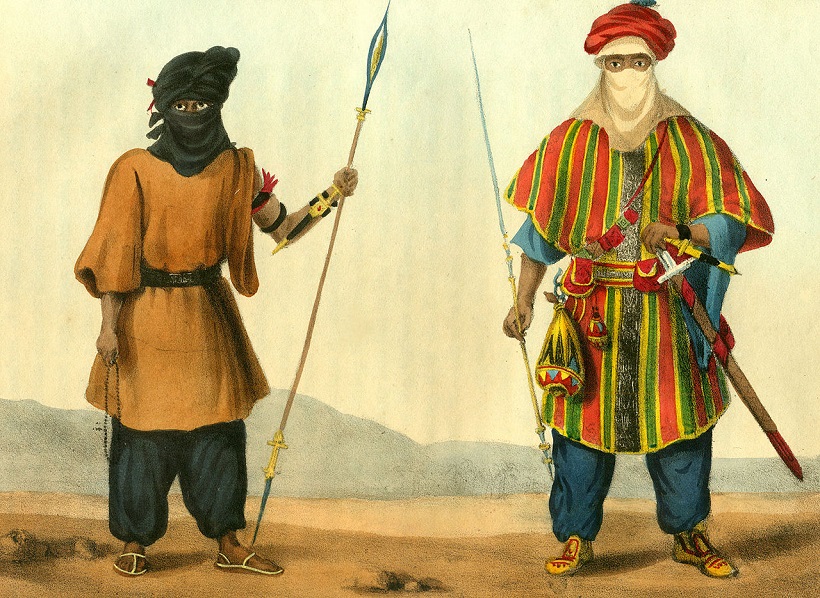
Illustration of two relatively-modern Tuareg fighters
The pact that a Roman auxiliary soldier signed up for was 25 years of service, and a reward
at the end of citizenship for him and his descendants. Like my Scott line, I expect our
Moorish auxiliary soldier of the Hollis line made a family with a local woman. The
Carvetii were the people associated with Carlisle, and they were closely related to the
Brigantes. Our Moorish man mixed in with those people and the line eventually adopted
the Hollis surname. I would wager that every single E-M2 line with British surnames came
from those Moorish men. The Moorish infantry served on the Danube around modern Germany
before they were deployed to the Wall, so they had a little more status to start with,
which might've set the trajectory of the Hollis family being prominent in medieval
England. The promise of Roman citizenship was probably more than enough to encourage
local women to take these men as husbands.
The area where the name Hollis was adopted is Derbyshire and Nottinghamshire,
which is some distance from Carlisle. I've seen this with many of my ancestral lines,
having an origin point in a fairly different part of England from where they emigrated to
America. Take the Carlile line for example, that obviously began in Carlisle, but as far
as I know, there aren't many Carliles in Carlisle today. I expect these were relatively
modern movements, though long before industrialization. Conflict seems to me to be the
most likely reason. But getting back to E-M2, another Moorish tribe was the Numidians,
who provided cavalry for the Romans. It doesn't seem that Numidians went specifically to
Britain, but maybe some Numidians, called the Maurorum, were actually part of the 500.
Hollises in England
So, though our Hollis line in Britain began with an African, he merged into one of the
Briton peoples that would make up the majority of English stock. See a map below of the
status of Britain at the time the Roman Empire disintegrated and withdrew. Our man had
been stationed a couple of centuries before, around Carlisle. He probably never left the
region labeled Maxima Caesariensis, and the people he merged into were probably
thoroughly Romanized.
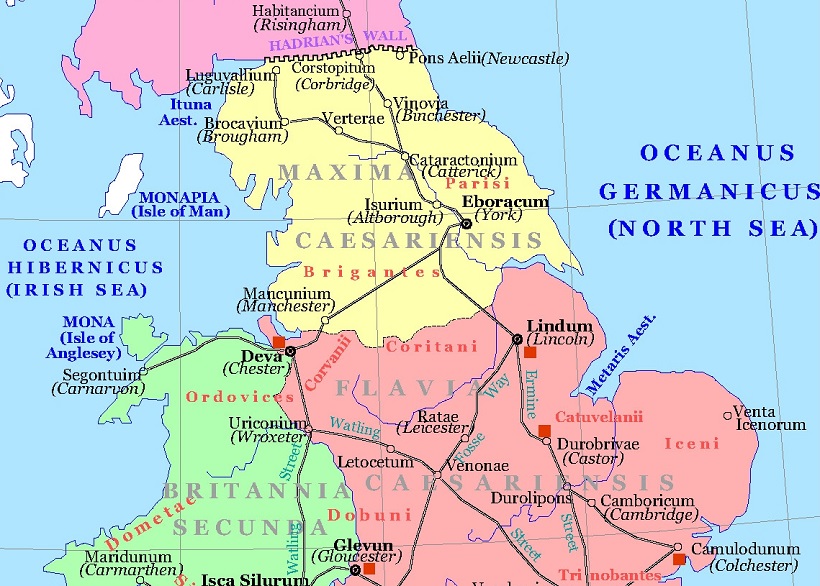
Britannia 410AD
See the next map for the state of Britain after the initial arrival of Anglo-Saxons.
Regardless of the resistance that was probably put up by our Hollis line, they became
English and part of the coming Mercian kingdom. See the map after. The Normans would
eventually come in 1066, but as Hollis is not a French name, our line kept to their
English/Celtic culture because they wouldn't have adopted a surname until centuries
after. That's probably because they were rural conservative people, and being more urban may
have made it more likely to be swayed culturally. English culture overall was very
much affected by the Normans, but it survived. I don't have a specific departure point
for John Hallowes, but John's claimed father was also called John, specifically "the carpenter", and he was
baptized 5 March 1587 according to the Rochdale parish register, near Manchester. This John's father is
also claimed to have been named John, which made our major John at least John Hollis III.
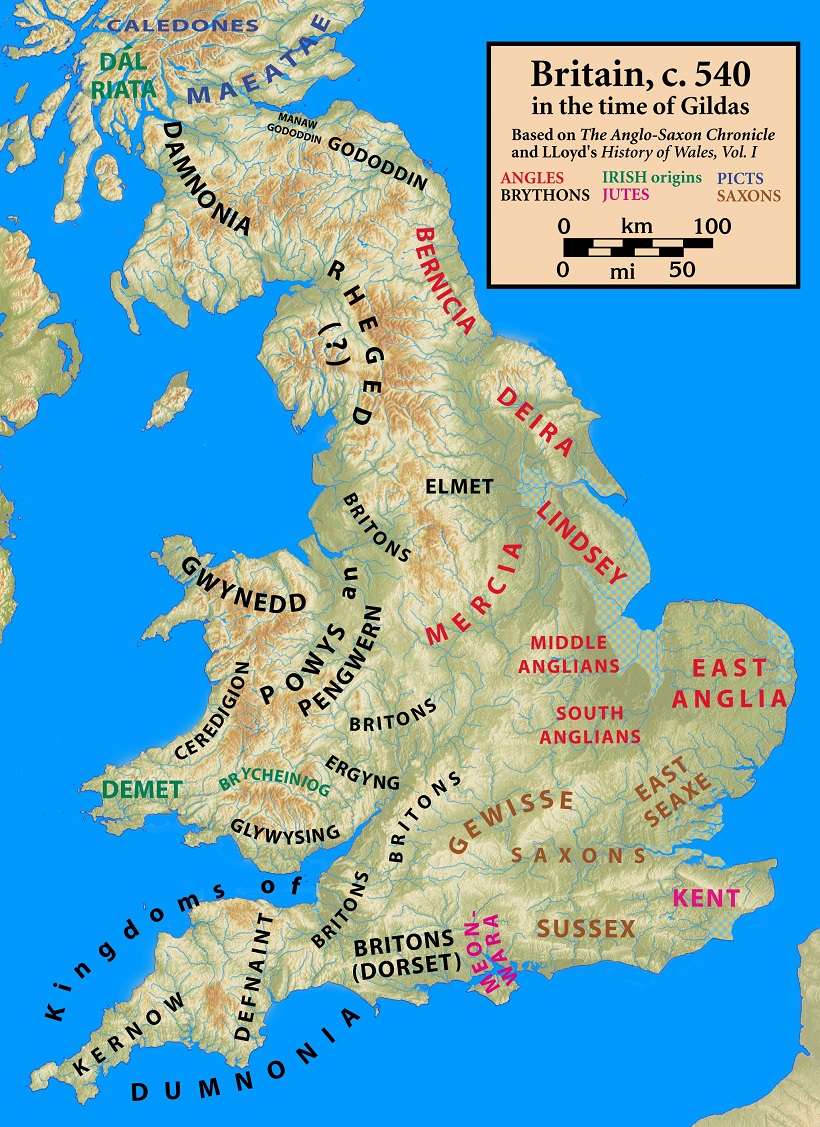
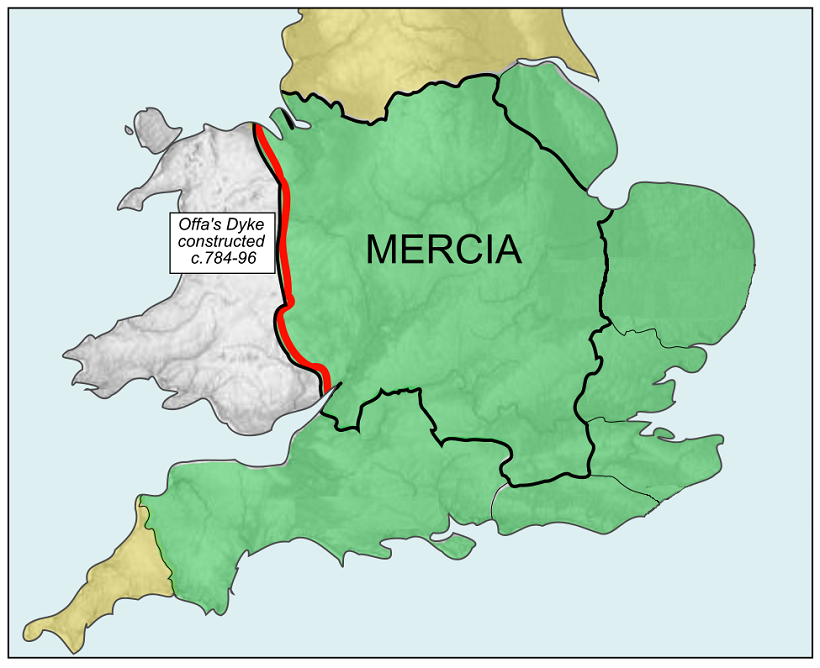
Kingdom of Mercia, prior to Norman Conquest
Our Line in Africa
Let's move now completely away from England to the African origin of our Hollis line.
E-M2 emerged about 42,000 years ago. At that time, the glacier over Europe and Siberia
had retreated and homo sapiens moved in. But our line was still in Africa, around the
head of the lower arrow in Africa in the
map below, going west out of the core stock of all humanity.

Two major empires emerged historically in North Africa. The first of course was the
Egyptians, who rose and fell over and over again. See a map below of the state of the
world in 1300 BC. Our line had nothing to do with Egypt, and I expect had already been
of a Berber culture for a long time, having come from the Saharan peoples. The closer
North African empire to our line was Carthage, which wasn't African so our folk likely had
nothing to do with that either. See the second map for the shape of things in 323 BC.
The Numidians were Berbers that our folk could've been part of, as has been mentioned.
See the third map below for the furthest extent of the Roman Empire which our line came
under the control of, and their situation upon going to Hadrian's Wall. It's quite an
amazing thing that DNA can tell us this story, which we never would've guessed was the case.


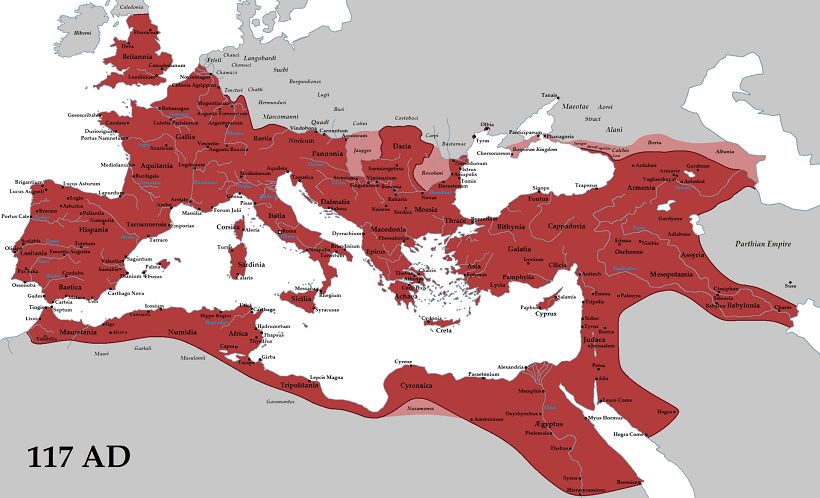
Eli Hollis's other Great-Great-Grandparent Lines
In the last phase of this document, I collect all that I know about the non-Hollis paternal lines of the great-great-grandparents of my great-great-grandfather, Eli Hollis. Refer to the McAtee Pedigree page for a simple view of Eli's ancestors.
Green
Rebecca Green was Eli Hollis's mother. She was born 1816 in Morgan County Georgia. Rebecca's father was John Green, born 1784 in Warren County North Carolina. He fought in the War of 1812. John's father was Josiah Green, born 1750 in what would be Warren County but was Granville County in 1750. He wed there in 1773, when it was now in Bute County. He raised his family there, when it had become part of Warren County. I believe he served in the Revolutionary War, but I don't know details. He moved the family to Georgia in 1799. Josiah's father was Joseph Green, born 1718 in Brunswick County Virginia. Joseph's father was Thomas, born about 1700 in Surry County Virginia. Thomas's father was Edward, born about 1670 in Charles City County Virginia. Edward's father was Thomas, born about 1640 in England. Though the Greens are the root of half of Eli Hollis's tree, I know nothing more about them. Josiah and earlier were slaveholders. Presumably the line was Anglican. I found no connection in the Green DNA project, so I have to guess Y-DNA haplogroup R-M269 which is most common.
Knighton
Polly Knighton was Elias Hollis's mother. Polly was born 1782 in Fairfield, Camden District South Carolina. Polly's father was Moses Knighton, born 1733 in King George County Virginia. Moses's father was also named Moses, born about 1690 in King George. Moses Sr's father was John, born about 1670 in Wootton Bassett, Wiltshire England. Moses Sr's second wife was our ancestor, who was Moses I Hollis's sister Susannah. It seems that the Knightons came to South Carolina because of Revolutionary War service, though info on the line is very confused. With so many Moseses, it's no wonder! The Knightons were also slaveholders. Presumably they were Anglican. I've had no luck finding Knighton Y-DNA information, so I have to guess they are haplogroup R-M269.
Wheelis
Rebecca Green's mother was Nancy Wheelis. Nancy was born 1785 in Surry County North Carolina. Nancy's father was Lewis Wheelis, born 1756 in Edgecombe County North Carolina. Lewis's father was Benjamin Wheelis, born 1713 in King William County Virginia. Benjamin was taken prisoner in Charleston South Carolina in the Revolutionary War. He was offered freedom in exchange for the release of a younger British prisoner, but he refused. Benjamin's father was Joseph Wheelis. Other researchers have placed him in Massachusetts. I've considered this to be incorrect, but I have found cases of ancestors moving directly from the upper colonies to the lower, especially if they were religious leaders. I don't know what the story is with our Wheelis line, but I do know that the name originates in Cornwall England. It's an odd name because it was anglicized from something similar to wheel. It has nothing to do with the name Wheeler, which was an occupation. The 'is' on the end of the name is similar to how Moore became Morris, and how Holly became Hollis. I believe the reason for it is saying it as a plural, like "I'm from the Hollies". The Wheelises (ha!) were not slaveholders. Presumably they were Anglican. Google gives me a perplexed response when attempting to search for Wheelis Y-DNA. Given the similarities between Cornwall and Wales, I assume the vast majority are of haplogroup R-M269.
Hagan
Rosannah Hagan was Elias Hollis's paternal grandmother and maternal great-grandmother. We thus have two Hagan lines due to this Hollis-to-Hagan-to-Knighton-to-Hollis connection. Rosannah was born 1735 in Queen Anne's County Maryland. Her father was Jacob Hagan, born 1710 in Charles County Maryland. The Hagans were probably familiar with the McAtees. They certainly were familiar with the Hollises. They're a curious connection between the families, as I doubt the Hollises were familiar with the McAtees at the time. Our Hagans moved to Fairfax County Virginia, long after the Hollises left Maryland. The name Berry is associated with both Jacob and Rosannah. I think the father probably went by Berry, but I doubt his daughter did. Jacob's father was Ensley Hagan, born 1674 in Bryantown of Charles County, the same year that Patrick McAtee arrived at St Mary's. Ensley's father was Leonidas, born 1650 in Eoghain, County Tyrone Ireland. Hagan is a native Irish surname. I presume they immigrated as Catholics, and probably remained so until they wed into the Hollises in Virginia. I have no evidence that the Hagans were slaveholders, but no male in the line lived into the 19th century. Descendants of the Hagans have been tested as Y-DNA haplogroup R-M269.
Williford
John Green's mother was Mary Williford, born 1748 in Isle of Wight County Virginia. Mary's father was Nathan Williford, born 1720 in Isle of Wight. Nathan's father was John Williford, born 1699 in Isle of Wight. John's father was also named John, born 1640 in Leicestershire England. Wikitree.com traces this line backward in England to James Wilsford who was the Sheriff of London, and his father Robert was the Mayor of Exeter. The surname Williford comes from a family that lived in Wilford, Nottinghamshire. They are believed to have been Norman in origin, though that would only make sense if the town was named after our line and not the other way around, because the only Norman part is Will, which is anglicized French. Presumably they were Anglican. Given their background and the family they wed into, I assume they were slaveholders. There's no Williford DNA project, so I have to guess they were Y-DNA haplogroup R-M269. They could've been I-M253 if they were Normans, but there's no clear evidence of it IMO.
Tindall
Nancy Wheelis's mother was Charlotte Tindall, born 1760 in Beaufort County North Carolina. Charlotte's father was Solomon Tindall, born 1730 in Burlington County New Jersey. Solomon's father was William Tindall, born 1694 in Nottingham of Burlington County. William's father was Thomas Tindall, born 1658 in Devonshire, England. The surname Tindall comes from the town Tynedale near Carlisle. I presume the line was Anglican. Given the path from New Jersey, I don't presume they were slaveholders. There is a Tindell DNA project that is predominantly Y-DNA haplogroup R-M269.
Canterbury
Moses I Hollis's mother was Esther Canterbury, born in 1700. Esther's father was John Canterbury, born 1680 in Surrey England. The line traces back to gentry in Kent. Other researchers place Esther's birth in England and that her father never emigrated. If that's accurate, then John Hallowes returned to England to wed her. But marriage is claimed in Fairfax Virginia in 1720. My assumption is she was born in Fairfax, and if her father died in England it was because he returned or his remains were returned. This line is too early to make any guess about slaveholding. They were presumably Anglican. All Canterburys tested for Y-DNA have been haplogroup R-M269.
Thompson
Rosannah Hagan's mother was Mary Thompson, born 1715 in Queen Anne's County Maryland. Her father was James Thompson, born 1696 in Belfast Ireland. I know nothing more specific about this line. Thompson is said to be a Scottish name, so it certainly looks like ours were Scots-Irish. Even so, I would presume they were Anglican, and I make no guess if they were slaveholders. The best assumption is this line was Y-DNA haplogroup R-M269.
Franks
Moses Knighton Jr's mother was Elizabeth Franks, born 1710 in Westmoreland County Virginia. Elizabeth's father was Robert Franks, born 1684 in Washington of Westmoreland County. Robert's father was also named Robert, born 1625 in Danby, Yorkshire England. Franks is a Norman name, meaning 'free'. Looking at the Frank DNA project, it looks like if someone from France had this name, they were of the Y-DNA I-M253 haplogroup, or Norman Viking.
Turner
Josiah Green's mother was Ann Turner, born 1720 in Bute County North Carolina. Ann's father was Joseph Turner, born 1685 in Isle of Wight County Virginia. Joseph's father was John Turner, born 1630 in Charles City County Virginia. John's father was James Turner, born 1593 in Chelmsford, Essex England. James was a very early immigrant to Virginia, but he didn't go to Jamestown. There's a Turner line in the Tapp tree that might be related. The name Turner comes from French, but it's such a common name that it can't be surely tied to Normans. The Turner DNA project is one of the few I've found that block you from reviewing the results if you're not a Turner. As if I don't have the right to know. But anyway, it probably should be assumed that it's Y-DNA haplogroup R-M269.
Johnson
Mary Williford's mother's name was Martha, born 1722 in Isle of Wight County Virginia. This line is so uncertain, it's not even clear what Martha's maiden name was. Her full name is claimed to be Martha Mary Wood Johnson. Sometimes when similar names like Martha and Mary are combined, it means that two separate people are being conflated. But I have seen cases of a combination like this actually being used. That said, info from ancestry.com for Martha have her living to be 100, which looks very much like a conflation. It could be that Martha's maiden name was Wood and she was the widow of a Johnson man. It could be the other way around. I haven't been able to sort it out, which is complicated by her living possibly her entire life before the Revolution. For this line, I assume it followed the typical English, Anglican, R-M269 pattern.
Sturdivant
Lewis Wheelis's mother was Harriett Sturdivant, born 1717. It's unclear who Harriett's father was, but she surely was related to Matthew Sturdivant born 1718 in Surry County Virginia. I assume that Harriett was born there, and he probably was her brother. Harriett was in Edgecombe County North Carolina by 1750, where she raised her family. Matthew's line arrived in Virginia from Wales by 1660. The claims for this line is it was originally English and first moved to Wales before coming to America. The name is English, meaning a messenger. It's a mixture of English start and French avaunt, meaning forward. It looks like this surname is Y-DNA haplogroup R-M269.
Parker
Charlotte Tindall's mother was Elizabeth Parker. The info on ancestry.com for her is that she was born in North Carolina. Her daughter was born in the far east of the state, so if that's accurate, she would be from very early settlers. Her husband was from New Jersey. I tend to doubt that she was born in North Carolina, or her family would be easier to find. Parker is likely English and R-M269.
Summary of Eli Hollis's Great-Great-Grandparent Lines
Only five of the sixteen lines were proven or presumed to be slaveholders, but keep in mind
that most lived too long ago to leave records. Given the pattern of this tree, I would
expect the majority to have been. Eli's ancestors were predominantly English and Anglican,
with a little Irish Catholic and Scottish. As is typical for my ancestors, it's predominantly
Y-DNA haplogroup R-M269, but a few could've been rarer strains where I guessed the most
common. At least one was the Norman Viking I-M253, and the Hollis line itself is the unique
African E-M2. Only the E-M2 Y-DNA came down to us, but the others do help in understanding
where Eli Hollis's ancestors came from. A few of the lines are so obscure that I didn't
attempt to define a migration path for them below.
Migration paths
Hollis: 1910 Wayne, McClain, Oklahoma - 1898 Mount Pleasant, Titus, Texas - 1881 Anderson, Lauderdale, Alabama - 1871 Roanoke, Randolph, Alabama -
1830 Dark Corner, Campbell, Georgia - 1780 Wateree Creek, Fairfield, South Carolina - 1720 Fairfax, Fairfax, Virginia -
1647 Nomini Bay, Northumberland, Virginia - 1635 St Mary's, St Mary's, Maryland - 1500 Rochdale, Lancashire, England -
120 Burgh-by-Sands, Carlisle, England - 0 Algiers, Algeria
Green: 1830 Goodes, Campbell, Georgia - 1799 Madison, Morgan, Georgia - 1750 Macon, Granville, North Carolina - 1718 Brunswick, Brunswick, Virginia -
1700 Surry, Surry, Virginia - 1670 Charles City, Charles City, Virginia - 0 Walsall, Staffordshire, England
Knighton: 1780 Fairfield, Fairfield, South Carolina - 1690 King George, King George, Virginia - 0 Wootton Bassett, Wiltshire, England
Wheelis: 1800 Madison, Morgan, Georgia - 1780 Dobson, Surry, North Carolina - 1750 Tarboro, Edgecombe, North Carolina -
1710 King William, King William, Virginia - 0 Truro, Cornwall, England
Hagan: 1750 Fairfax, Fairfax, Virginia - 1730 Centreville, Queen Anne, Maryland - 1700 Bryantown, Charles, Maryland - 0 Eoghain, Tyrone, Ireland
Williford: 1760 Warrenton, Warren, North Carolina - 1690 Isle of Wight, Isle of Wight, Virginia - 1600 Leicester, Leicestershire, England -
0 Nottingham, Nottinghamshire, England
Tindall: 1750 Beaufort, North Carolina - 1690 Nottingham, Burlington, New Jersey - 0 Devon, Devonshire, England
Canterbury: 1700 Fairfax, Fairfax, Virginia - 0 Guildford, Surrey, England
Thompson: 1715 Centreville, Queen Anne, Maryland - 1650 Belfast, Antrim, Ireland - 0 Dumfries, Dumfriesshire, Scotland
Franks: 1730 King George, King George, Virginia - 1660 Washington, Westmoreland, Virginia - 1100 Danby, Yorkshire, England -
700 Rouen, Normandy, France - 0 Aalborg, Denmark
Turner: 1750 Oxford, Granville, North Carolina - 1720 Warren, Bute, North Carolina - 1680 Isle of Wight, Isle of Wight, Virginia -
1625 Charles City, Charles City, Virginia - 0 Chelmsford, Essex, England
Sturdivant: 1750 Tarboro, Edgecombe, North Carolina - 1660 Surry, Surry, Virginia - 0 Nottingham, Nottinghamshire, England
last edited 1 Nov 2022
